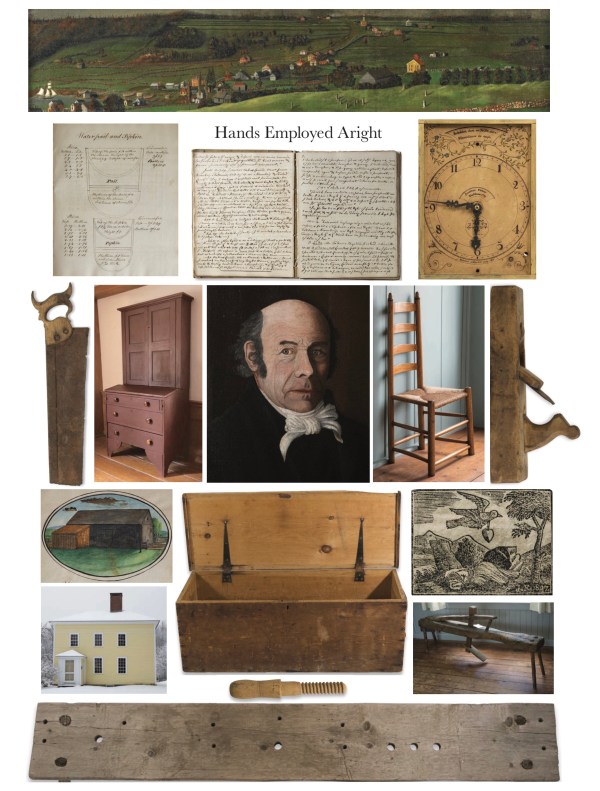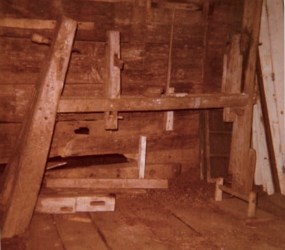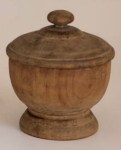
I’ve read Joshua Klein’s new book “Hands Employed Aright” at least five times to complete the index and also for pleasure. It is one of my favorite books I’ve read so far this year.
To say that Jonathan Fisher, the subject of the book, was an industrious man is an understatement. He was at various and overlapping times: artist, author, builder (of house, barn, workshop), clockmaker, cooper, furniture maker, hat maker, linguist, lock maker, pipe (of the drainage type) maker, surveyor, toolmaker and turner. Oh, I know there are several more I left out. He did all this as the husband of Dolly, the father of nine children and the Congregationalist minister for his frontier community of Blue Hill, Maine. Fisher was also, as were many men of his time, a prolific diarist.
The primary materials available to Joshua included a huge volume of diary entries, Fisher’s house, letters, publications, artwork, furniture and tools held in several collections in Maine. Such an abundance of primary materials, although welcome, can be daunting for a researcher. What to cull and what to keep? What patterns emerge? Details that might be fascinating or endearing to the researcher may not advance the themes intended for the final manuscript.
For five years Joshua Klein dove in and swam with Fisher. He read the letters and the diaries, studied the furniture, tools and other items (some of which remain to be identified). He consulted with Don Williams and other experts. He tried to absorb how Fisher combined the strength of his mind and faith with his oftentimes weak body, yet skillful hands, to produce such a prodigious output.
 Along the way Joshua was able to solve a few puzzles. Using old photographs taken prior to the destruction of the Fisher barn he figured out that some of the bits and pieces were one of Fisher’s lathes. And in his shop-based research – a chapter worth the price of admission – Joshua demystifies the odd mouse-shaped totes on many of Fisher’s planes. He explores working on a low workbench and learned several new approaches to his own woodworking.
Along the way Joshua was able to solve a few puzzles. Using old photographs taken prior to the destruction of the Fisher barn he figured out that some of the bits and pieces were one of Fisher’s lathes. And in his shop-based research – a chapter worth the price of admission – Joshua demystifies the odd mouse-shaped totes on many of Fisher’s planes. He explores working on a low workbench and learned several new approaches to his own woodworking.
You do not have to be a woodworker to enjoy this book. It is also a social and economic history of life on the American frontier. It is a continuation of the story that began with James Rosier’s account of the European discovery of Maine in 1605 (when Maine was part of the then vast colony of Virginia). The illustrations of Fisher’s artwork and designs and photographers of his home and furniture are plentiful and stellar.
 Joshua Klein’s abilities as a researcher shine in this book. He has distilled a tremendous amount of information and observation into a cogent history of the life and talents of the fascinating Jonathan Fisher. Joshua also acknowledges the research is not over and very generously ends his book with a detailed catalog of all of Fisher’s furniture (including pieces attributed to him) and tools for potential use by others.
Joshua Klein’s abilities as a researcher shine in this book. He has distilled a tremendous amount of information and observation into a cogent history of the life and talents of the fascinating Jonathan Fisher. Joshua also acknowledges the research is not over and very generously ends his book with a detailed catalog of all of Fisher’s furniture (including pieces attributed to him) and tools for potential use by others.
Joshua used a quote by Jonathan Fisher as the title for his book. I think “Hands Employed Aright” is an apt description of Joshua’s work, too.
— Suzanne Ellison
The images used in the collage: top row is a portion of ‘A morning view of Blue Hill’ by Fisher, Farnsworth Art Museum. 2nd row (left & middle) coopering plans, Fisher’s diary, both from the Jonathan Fisher Memorial; clock face, Farnsworth Art Museum. 3rd row (middle) detail from Fisher’s 1825 self portrait, Blue Hill Congregational Church; back saw, desk and bookcase, slat-back chair and fore plane are from the Farnsworth Art Museum. 4th row (middle) chest for tool storage and wooden screw, Farnsworth Art Museum; painting of the barn and workshop (top left), woodblock print and shaving horse (right) all by Fisher in the collection of the Jonathan Fisher Memorial; the yellow house (bottom left) is the Fisher home. Bottom row is the top of Fisher’s low workbench, Jonathan Fisher Memorial.